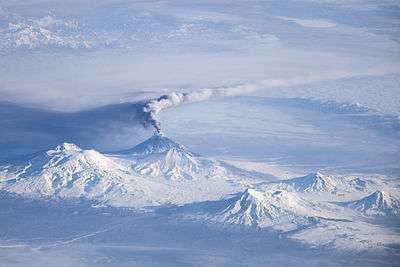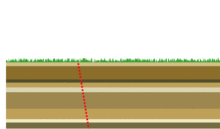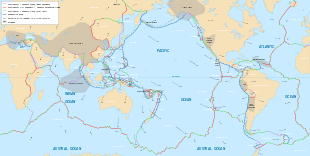Mountain formation

Mountain formation refers to the geological processes that underlie the formation of mountains. These processes are associated with large-scale movements of the Earth's crust (plate tectonics).[1] Folding, faulting, volcanic activity, igneous intrusion and metamorphism can all be parts of the orogenic process of mountain building.[2] The understanding of specific landscape features in terms of the underlying tectonic processes is called tectonic geomorphology, and the study of geologically young or ongoing processes is called neotectonics.[3]
Types of mountains
There are three main types of mountains: volcanic, fold, and block.[4] A more detailed classification useful on a local scale predates plate tectonics and adds to these categories.[5]
Volcanic mountains

Movements of tectonic plates create volcanoes along the plate boundaries, which erupt and form mountains. A volcanic arc system is a series of volcanoes that form near a subduction zone where the crust of a sinking oceanic plate melts.[8]
Most volcanoes occur in a band encircling the Pacific Ocean (the Pacific Ring of Fire), and in another that extends from the Mediterranean across Asia to join the Pacific band in the Indonesian Archipelago. The most important types of volcanic mountain are composite cones or stratovolcanoes (Vesuvius, Kilimanjaro and Mount Fuji are examples) and shield volcanoes (such as Mauna Loa on Hawaii, a hotspot volcano).[9][10]
A shield volcano has a gently sloping cone due to the low viscosity of the emitted material, primarily basalt. Mauna Loa is the classic example, with a slope of 4°-6°. (The relation between slope and viscosity falls under the topic of angle of repose.[11]) The composite volcano or stratovolcano has a more steeply rising cone (33°-40°),[12] due to the higher viscosity of the emitted material, and eruptions are more violent and less frequent than for shield volcanoes. Besides the examples already mentioned are Mount Shasta, Mount Hood and Mount Rainier.[13]
Fold mountains
When plates collide or undergo subduction (that is – ride one over another), the plates tend to buckle and fold, forming mountains. Most of the major continental mountain ranges are associated with thrusting and folding or orogenesis. Examples are the Jura and the Zagros mountains.[14]
Block mountains
When a fault block is raised or tilted, block mountains can result.[16] Higher blocks are called horsts and troughs are called grabens. A spreading apart of the surface causes tensional forces. When the tensional forces are strong enough to cause a plate to split apart, it does so such that a center block drops down relative to its flanking blocks.
An example is the Sierra Nevada Range, where delamination created a block 650 km long and 80 km wide that consists of many individual portions tipped gently west, with east facing slips rising abruptly to produce the highest mountain front in the continental United States.[17][18]
Uplifted passive margins
Unlike orogenic mountains there is no geophysical model that explains elevated passive continental margins such as the Scandinavian Mountains, Eastern Greenland, the Brazilian Highlands or Australia's Great Dividing Range.[19][20]
Models
Hotspot volcanoes
Hotspots are supplied by a magma source in the Earth's mantle called a mantle plume. Although originally attributed to a melting of subducted oceanic crust, recent evidence belies this connection.[21] The mechanism for plume formation remains a research topic.
Fault blocks
Several movements of the earth's crust that lead to mountains are associated with faults. These movements actually are amenable to analysis that can predict, for example, the height of a raised block and the width of an intervening rift between blocks using the rheology of the layers and the forces of isostasy. Early bent plate models predicting fractures and fault movements have evolved into today's kinematic and flexural models.[22][23]
See also
Notes
- ↑ Steven M. Stanley (2004). "Mountain building". Earth system history (2nd ed.). Macmillan. p. 207. ISBN 0-7167-3907-0.
- ↑ Robert J. Twiss; Eldridge M. Moores (1992). "Plate tectonic models of orogenic core zones". Structural Geology (2nd ed.). Macmillan. p. 493. ISBN 0-7167-2252-6.
- ↑ Kurt Stüwe (2007). "§4.5 Geomorphology". Geodynamics of the lithosphere: an introduction (2nd ed.). Springer. p. 178. ISBN 3-540-71236-4.
- ↑ "Chapter 6: Mountain building". Science matters: earth and beyond; module 4. Pearson South Africa. 2002. p. 75. ISBN 0-7986-6059-7.
- ↑ Andrew Goudie (2004). Encyclopedia of geomorphology; Volume 2. Routledge. p. 701. ISBN 0-415-32738-5.
- ↑ NASA - Activity at Kliuchevskoi
- ↑ Victor Schmidt; William Harbert (2003). Planet Earth and the New Geoscience (4th ed.). Kendall Hunt. pp. 46–47. ISBN 0-7872-9355-5.
- ↑ Stephen D Butz (2004). "Chapter 8: Plate tectonics". Science of Earth Systems. Thompson/Delmar Learning. p. 136. ISBN 0-7668-3391-7.
- ↑ John Gerrard (1990). "Types of volcano". Mountain environments: an examination of the physical geography of mountains. MIT Press. p. 194. ISBN 0-262-07128-2.
- ↑ Robert Wayne Decker; Barbara Decker (2005). "Chapter 8: Hot spots". Volcanoes (4th ed.). Macmillan. p. 113 ff. ISBN 0-7167-8929-9.
- ↑ Arthur Holmes; Donald Duff (2004). Holmes Principles of Physical Geology (4th ed.). Taylor & Francis. p. 209. ISBN 0-7487-4381-2.
- ↑ Transactions of the American Society of Civil Engineers, Volume 39. American Society of Civil Engineers. 1898. p. 62.
- ↑ James Shipman; Jerry D. Wilson; Aaron Todd (2007). "Minerals, rocks and volcanoes". An Introduction to Physical Science (12th ed.). Cengage Learning. p. 650. ISBN 0-618-93596-7.
- ↑ Michael P Searle (2007). "Diagnostic features and processes in the construction and evolution of Oman-, Zagros-, Himalayan-, Karakoram-, and Tibetan type orogenic belts". In Robert D. Hatcher Jr.; MP Carlson; JH McBride & JR Martinez Catalán. 4-D framework of continental crust. Geological Society of America. p. 41 ff. ISBN 0-8137-1200-9.
- ↑ Chris C. Park (2001). "Figure 6.11". The environment: principles and applications (2nd ed.). Routledge. p. 160. ISBN 0-415-21770-9.
- ↑ Scott Ryan (2006). "Figure 13-1". CliffsQuickReview Earth Science. Wiley. ISBN 0-471-78937-2.
- ↑ John Gerrard (1990-04-12). Reference cited. p. 9. ISBN 0-262-07128-2.
- ↑ Lee, C.-T.; Yin, Q; Rudnick, RL; Chesley, JT; Jacobsen, SB (2000). "Osmium Isotopic Evidence for Mesozoic Removal of Lithospheric Mantle Beneath the Sierra Nevada, California" (PDF). Science. 289 (5486): 1912–6. Bibcode:2000Sci...289.1912L. doi:10.1126/science.289.5486.1912. PMID 10988067.
- ↑ Bonow, Johan M. (2009). "atlantens kustberg och högslätter – gamla eller unga?" (PDF). www.geografitorget.se (in Swedish). Geografilärarnas Riksförening.
- ↑ Green, Paul F.; Lidmar-Bergström, Karna; Japsen, Peter; Bonow, Johan M.; Chalmers, James A. (2013). "Stratigraphic landscape analysis, thermochronology and the episodic development of elevated, passive continental margins". Geological Survey of Denmark and Greenland Bulletin. 30: 18. Retrieved 30 April 2015.
- ↑ Y Niu & MJ O'Hara (2004). "Chapter 7: Mantle plumes are NOT from ancient oceanic crust". In Roger Hékinian; Peter Stoffers & Jean-Louis Cheminée. Oceanic hotspots: intraplate submarine magmatism and tectonism. Springer. p. 239 ff. ISBN 3-540-40859-2.
- ↑ AB Watts (2001). "§7.2 Extensional tectonics and rifting". Isostasy and flexure of the lithosphere. Cambridge University Press. p. 295. ISBN 0-521-00600-7.
- ↑ GD Karner & NW Driscoll (1999). "Style, timing and distribution of tectonic deformation across the Exmouth Plateau, northwest Australia, determined from stratal architecture and quantitative basin modelling". In Conall Mac Niocaill & Paul Desmond Ryan. Continental tectonics. Geological society. p. 280. ISBN 1-86239-051-7.
External links
- NASA Goddard Planetary Geodynamics Laboratory
- NASA Goddard Planetary Geodynamics Laboratory: Volcanology Research
- Rotating globe showing areas of earthquake activity

